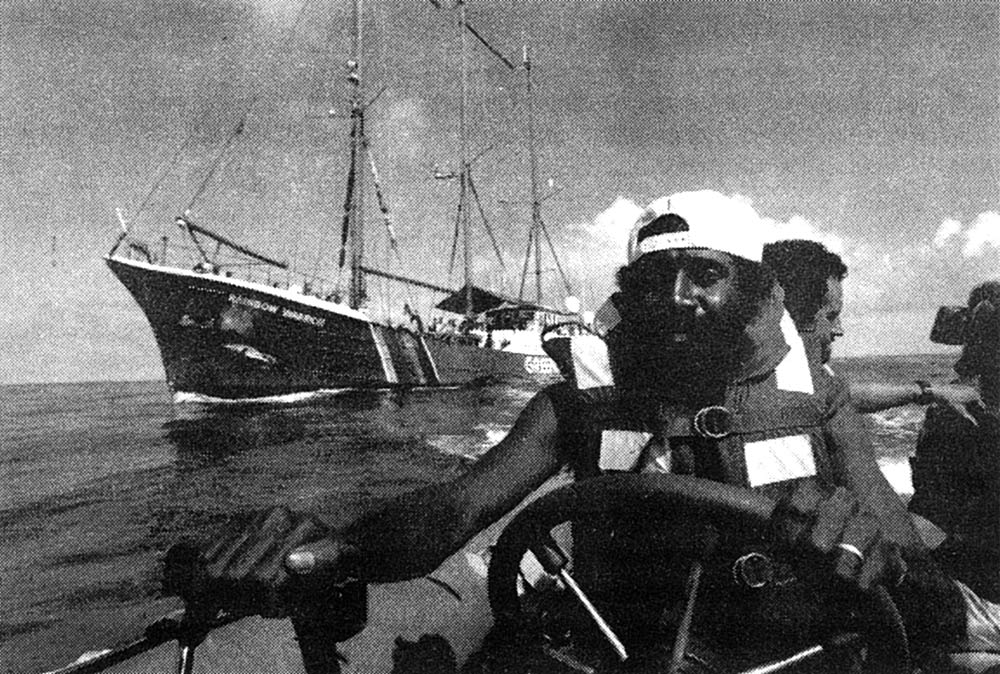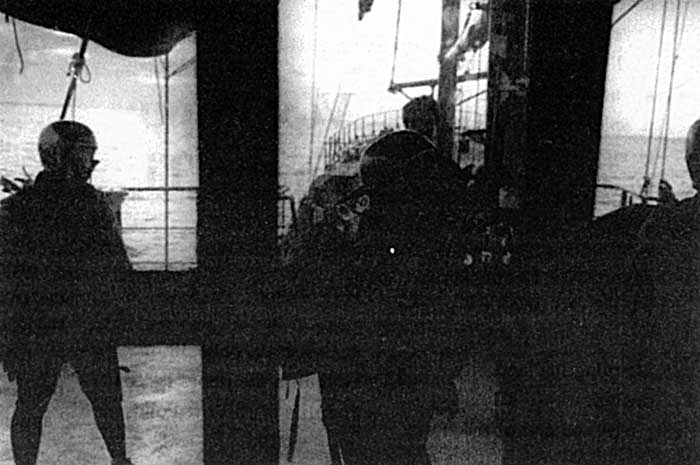
International SQUALL
Letter From New Zealand
Glyn Walters, South-Pacific Greenpeace Press Officer, sends us some reasons for the international radioactive heat over French nuclear testing.
Squall 11, Autumn 1995, pg. 85.
Moruroa, in the Maohi language of Polynesia, means the Place of the Great Secret.
Today this is a cruelly appropriate name for this once incredibly beautiful palm-covered atoll in the Tuamotu Islands, French Polynesia. For here, and at nearby Fangataufa atoll, the French government have carried out 44 atmospheric and more than 130 underground nuclear test explosions since 1966. Now, after a 4 year moratorium, the new President of France, M. Chirac has outraged Pacific and world public opinion by announcing a resumption of nuclear testing.
The health impacts of nuclear weapons testing has long been the subject of major controversy. An independent health study of French Polynesian people has never been carried out and military health records of test site workers have not been released. However, radiation from the atmospheric tests has been detected as far away as New Zealand, and according to testimonies from Polynesians and workers at the sites, rates of cancer, birth abnormalities and other illnesses have all increased since testing began.
Similarly, no rigorous, independent studies of the environmental effects of testing have ever been permitted. Several scientific missions to Moruroa, all of which had severely limited access to the site, have raised serious questions about the atoll’s ability to contain its radioactivity. It is, in effect, a huge, unregulated radioactive waste dump.
Moruroa and Fangataufa: it’s only paradise if you don’t live here.”
Caesium 134 and iodine 131 were found in the central lagoon during Jacques Cousteau’s 1987 study, indicating leakage was occurring. In 1991, the International Atomic Energy Agency (of all people!) found elevated levels of plutonium 12 miles from the atoll. Other studies have questioned the geological stability of the atoll (a former volcano), and Cousteau himself filmed spectacular underwater cracks and submarine landslides caused by the testing. He said the atoll was suffering ‘premature and accelerated ageing’. The threat of widespread radioactive contamination of the whole Pacific marine environment appears to be a very real possibility, and all it may need is one more nuclear test...
Since 1972 and the first Greenpeace actions at Moruroa, activists from Australia, New Zealand and the Pacific have been physically protesting at the site by sailing small yachts into the test zone and taking on the full might of the French military. This has given Greenpeace a special relationship with ordinary people in the region, a relationship that is older and very different to its European operations. The embarrassing world focus that these early actions brought forced the French government to finally move its nuclear tests underground in 1974.

New Zealand and Australia also took France to the World Court in 1973; the court decided France was acting illegally, so France promptly refused to recognise the World Court decision. The same countries have just reopened that Court case, with the support (so far) of four Pacific states: Western Samoa, The Solomons, The Marshall Islands and the Federated States of Micronesia.
The death of Fernando Pereira, killed when French Secret Service agents blew up the Rainbow Warrior in Auckland harbour in 1985, was a major turning point for the anti-nuclear movement in New Zealand and the rest of the Pacific. It shocked the world and cemented New Zealand’s now well-established anti-nuclear policy into place. Appropriately, the final campaign of the original Rainbow Warrior had been to relocate the residents of Rongelap atoll, contaminated by US nuclear testing in the Marshall Islands in the 1950’s. The US had ignored their pleas for help.
Today, in 1995, 10 years since that outrage, the new Rainbow Warrior has been protesting at Moruroa. On July 10 the ship was boarded, rammed and the crew tear-gassed by the French military, pictures of which were shown all over the world. All those crew arrested gave their names as “Fernando Pereira” in respect to his memory. In a large scale repeat of earlier sailings, an international Peace Flotilla of two dozen small boats accompanied by a New Zealand Navy ship sailed the 3,000 miles through tough, wintry seas to the atoll, to support the Greenpeace boats’ protest.
These peaceful protesters need all the support they can get to stop the French military and the other nuclear weapons states waiting in the wings from restarting the nuclear arms race and returning to the bad old days of the Cold War. The Comprehensive Test Ban Treaty must be signed next year, before France and China give the other nuclear weapons states (the UK, US and Russia) the excuse they need to avoid signing it and to begin nuclear testing again themselves. Incidentally, the UK government is the ONLY Commonwealth country not to have condemned France; all in all, 154 countries are opposed to renewed French testing. The latest polls in France itself show over 60 per cent opposition to the tests.
Squall readers can show their solidarity with the avowedly anti-nuclear peoples of the South Pacific by giving the French authorities in Europe as much grief as possible over the coming months. They fully deserve it.
